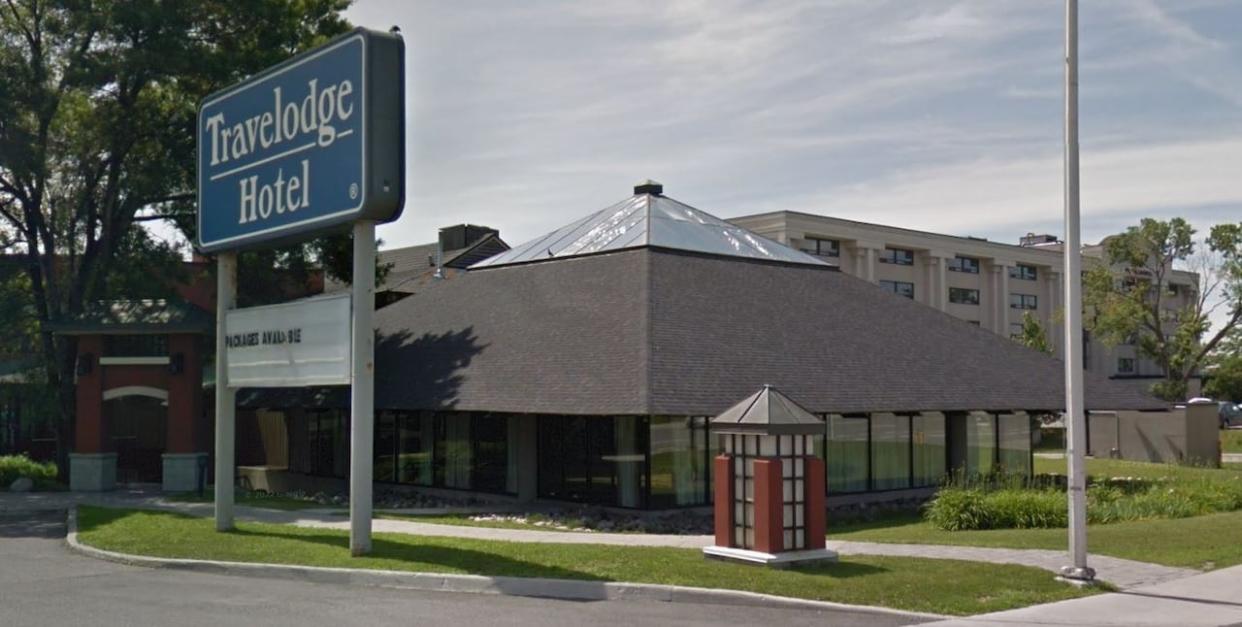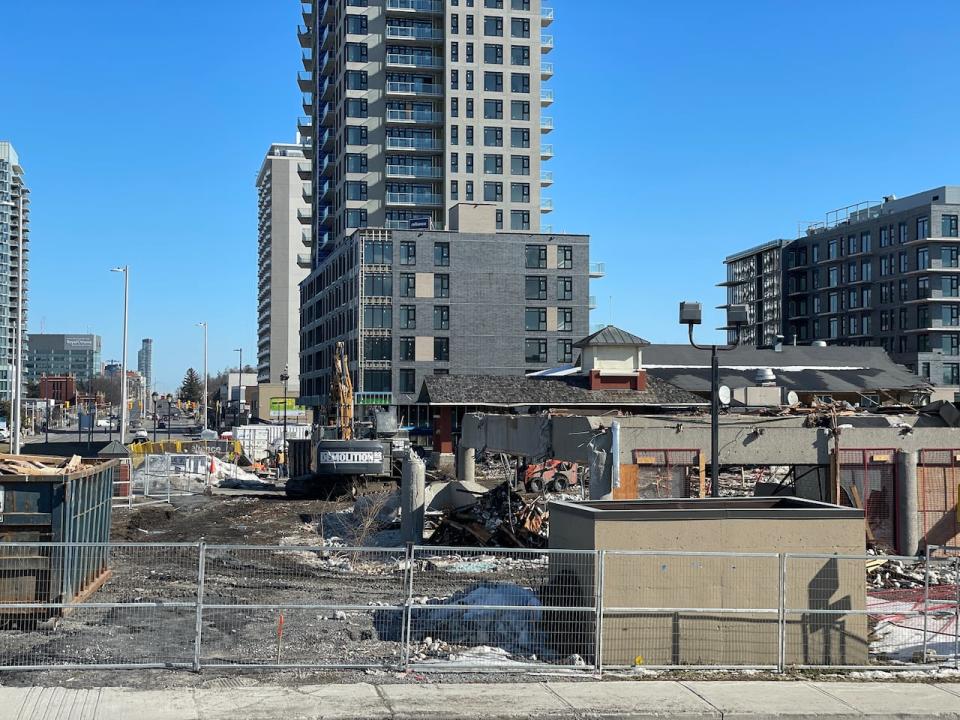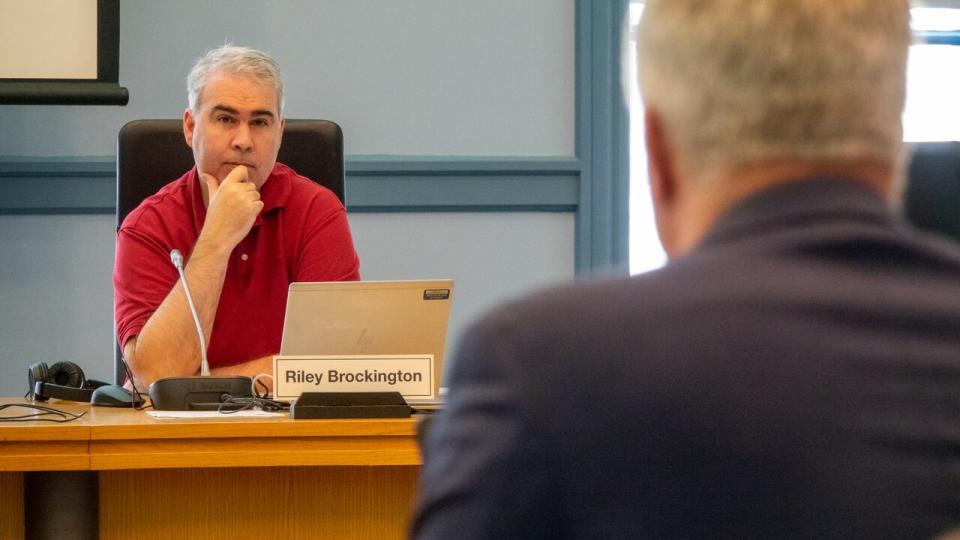'Tiki hut' at former Carling Avenue hotel torn down

The Japanese pavilion at the former Travelodge Hotel on Carling Avenue is gone, to the surprise and dismay of the local councillor — but the developer says a structure in the same spirit will rise from the rubble.
The pavilion, built as an addition to what was then the Talisman Motor Inn, was listed on Ottawa's heritage registry. It was also known as the "Japanese steakhouse" and sometimes as the "tiki hut," since its basement once hosted a popular tiki bar called the Beachcomber Room.
River Coun. Riley Brockington said he was told about the demolition on Monday. When he went to visit the site where several new highrises are being built, he saw nothing left but the building's concrete skeleton.
He called the pavilion "a unique, historic feature and part of our city's history."
"If the city was aware, then there's probably an onus to inform the community," he said. "I was not expecting to see this structure come down."
The city was aware.

The site of the former Japanese pavilion on Tuesday after demolition work. (Michel Aspirot/CBC)
Historical 'landmark'
The Talisman Motor Inn was developed by Harold Shenkman and Bill Teron, who was perhaps best known for the development of Kanata's first community of Beaverbrook.
According to one city report, the original inn was inspired by their Japanese travels.
When council approved a zoning by-law amendment in 2018 to allow for the highrise project, plans foresaw the "retention" of the Japanese pavilion as a "key component."
A staff report emphasized its "design, historical and contextual value," calling it "a landmark" and "a rare example of Japanese influenced architecture in Ottawa."
But council approval isn't the end of the process. As the developer submitted more precise plans to the city bureaucracy, it asked to relocate the pavilion "to better accommodate parking structures," as city staff put it, and to fit it in with a Japanese garden planned for the site.
Early versions of site plan drawings show two levels of underground parking beneath the pavilion.
"The applicant advised staff that the pavilion was in poor condition and could no longer be relocated and instead proposed reconstruction as part of the project," said an emailed statement from Lesley Collins, program manager for the city's heritage planning branch.
"Staff agreed with this approach."
Community will be 'thrilled' with result, says developer
Coun. Jeff Leiper, the city's planning and housing commission chair, said his understanding was that council anticipated the pavilion would remain when it approved the zoning change — but it wasn't a condition for the project to go forward.
Information about the demolition plan was available publicly, though it requires some detective work to track it down in a 2021 site plan document on the city's development website.
It notes that the pavilion rests on the foundation of the main hotel, whose planned demolition "would very likely result in structural damage to the pavilion" without steel reinforcement that could alter its appearance.
"Luckily, we are in possession of the original drawings of the building, and because of its simplicity we can recreate it to its original appearance," the document adds.
According to the site plan, some of the materials had changed over the years and others were "dated and of poor quality."
Tom Casey, chief financial officer and co-president of developer Holloway Lodging Corporation, said the plan is now to "reconstruct the pavilion in the same spirit and location as part of the design for our Talisman development."
"I am confident the community will be thrilled with the end-product of the brand-new Talisman, which will be five beautiful towers with over 1,000 rental units, extensive tenant amenities, parkland, and of course, a Japanese-style pavilion," he said in an email.
Casey did not respond to a question about whether any original materials will be used in the reconstructed pavilion.
Brockington said most of the materials appear to be gone. He's concerned the new plan takes away from the heritage character of the pavilion.
City staff need to do a better job of communicating their agreements with the public, he added.

River Coun. Riley Brockington. (Francis Ferland/CBC)
Heritage notification missed due to 'internal error'
Collins said there was an "internal error" in one notification step.
Given the pavilion's listing on the heritage registry, the law requires 60 days notice to council prior to demolition. She said that did not happen before the city issued a demolition permit.
"However, staff reviewed the permit application and given staff involvement in the process for the past six years, there were no objections to the proposed demolition and the construction of a replica in its place," she said.
David Flemming of Heritage Ottawa called the pavilion "a bit of an iconic building." He said he's "very disappointed" to see it go.
"I remember when that came to planning committee and council. They made a big point of incorporating that into the new construction," he said.
"The case was made that this was a very important structure … the arguments that were used were that it would be an enhancement to the new development and it should be preserved, because it meant a lot to the community."


